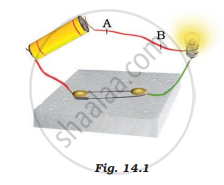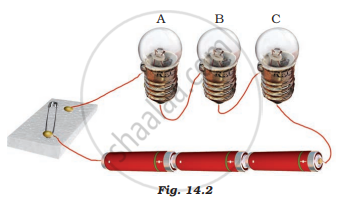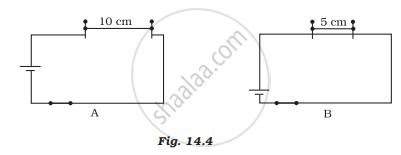Advertisements
Online Mock Tests
Chapters
2: Nutrition in Animals
3: Fibre to Fabric
4: Heat
5: Acids, Bases and Salts
6: Physical and Chemical Changes
7: Weather, Climate and Adaptation of Animals to Climate
8: Wind, Storm and Cyclone
9: Soil
10: Respiration in Organisms
11: Transportation in Animals and Plants
12: Reproduction in Plants
13: Motion and Time
▶ 14: Electric Current and Its Effects
15: Light
16: Water : A Precious Resource
17: Forests : Our Lifeline
18: Wastewater Story
![NCERT Exemplar solutions for Science [English] Class 7 chapter 14 - Electric Current and Its Effects NCERT Exemplar solutions for Science [English] Class 7 chapter 14 - Electric Current and Its Effects - Shaalaa.com](/images/science-english-class-7_6:5f2b1b2038084cf381bfa42c826a928c.jpg)
Advertisements
Solutions for Chapter 14: Electric Current and Its Effects
Below listed, you can find solutions for Chapter 14 of CBSE NCERT Exemplar for Science [English] Class 7.
NCERT Exemplar solutions for Science [English] Class 7 14 Electric Current and Its Effects MULTIPLE CHOICE QUESTIONS [Pages 75 - 76]
When an electric current flows through a copper wire AB as shown in Figure14.1, the wire

deflects a magnetic needle placed near it.
becomes red hot.
gives electric shock.
behaves like a fuse
Choose the statement which is not correct in the case of an electric fuse.
Fuses are inserted in electric circuits of all buildings
There is a maximum limit on the current that can safely flow through the electric circuits.
There is a minimum limit on the current that can safely flow in the electric circuits.
If a proper fuse is inserted in a circuit it will blow off if the current exceeds the safe limit.
Three bulbs A, B, and C are connected in a circuit as shown in Figure 14.2. When the switch is ‘ON’

bulb C will glow first.
bulb B and C will glow simultaneously and bulbs A will glow after some time.
all the bulbs A, B and C will glow at the same time.
the bulbs will glow in the order A, B and C.
When a switch is in the OFF position,
(i) circuit starting from the positive terminal of the cell stops at the switch.
(ii) circuit is open.
(iii) no current flows through it.
(iv) current flows after some time. Choose the combination of the correct answers from the following.
all are correct
(ii) and (iii) are correct
only (iv) is correct
only (i) and (ii) are correct
Which of the following precautions need not be taken while using electric gadgets/appliances/circuits?
We should never touch a lighted electric bulb connected to the mains.
We should never experiment with the electric supply from the mains or a generator or an inverter.
We should never use just any wire or strip of metal in place of a fuse.
We should never turn the switch in the ON position.
NCERT Exemplar solutions for Science [English] Class 7 14 Electric Current and Its Effects VERY SHORT ANSWER QUESTIONS [Page 77]
Which property of a conducting wire is utilised in making an electric fuse?
Name the device used these days in place of electric fuses in electrical circuits.
Fill in the blanks:
Our body is a ________________ of electricity.
An electric cell produces electricity from the __________ ___________ in it.
In an electric circuit a fuse is a _________ _______ to prevent possible fire.
A combination of two or more cells is called a _________.
Unscramble the following words:
TBTAYER
Unscramble the following words:
SFEU
Unscramble the following words:
HTRCO
Unscramble the following words:
HICWTS
Paheli does not have a night lamp in her room. She covered the bulb of her room with a towel at the night to get dim light. Has she taken the right step? Give one reason to justify your answer.
Why are compact fluorescent lamps (CFLs) preferred over electric bulbs?
Why is an electric fuse required in all electrical appliances?
NCERT Exemplar solutions for Science [English] Class 7 14 Electric Current and Its Effects SHORT ANSWER QUESTIONS [Pages 77 - 78]
Can we use the same fuse in a geyser and a television set? Explain.
Name two electric devices for each where
(i) the heating effect of current is used and
(ii) the magnetic effect of current is used.
Why do we cover plug pinholes which are within the reach of children with sellotape or a plastic cover when not in use?
Boojho made an electromagnet by winding 50 turns of wire over an iron screw. Paheli also made an electromagnet by winding 100 turns over a similar iron screw. Which electromagnet will attract more pins? Give reason.
NCERT Exemplar solutions for Science [English] Class 7 14 Electric Current and Its Effects LONG ANSWER QUESTIONS [Pages 78 - 79]
Your teacher has shown you the following activity.

Activity: The teacher has wound a long insulated piece of wire around an iron nail in the form of a coil. The free ends of the wire are connected to a cell through a switch as shown in Figure 14.3. The current is switched on and some pins are placed near the ends of the nail.
Write down any three questions that come to your mind about this activity
Paheli took a wire of length of 10 cm. Boojho took a wire of 5 cm of the same material and thickness. Both of them connected the wires as shown in the circuit given in Figure 14.4. The current flowing in both circuits is the same.
(i) Will the heat produced in both cases be equal? Explain
(ii) Will the heat produced be the same if the wires taken by them are of equal lengths but of different thicknesses? Explain.

How does the magnetic effect of electric current help in the working of an electric bell? Explain with the help of a diagram.
Draw the symbols of the following circuit components.
electric cell
Draw the symbols of the following circuit components.
switch in off position
Draw the symbols of the following circuit components.
electric bulb
Draw the symbols of the following circuit components.
battery
Solutions for 14: Electric Current and Its Effects
![NCERT Exemplar solutions for Science [English] Class 7 chapter 14 - Electric Current and Its Effects NCERT Exemplar solutions for Science [English] Class 7 chapter 14 - Electric Current and Its Effects - Shaalaa.com](/images/science-english-class-7_6:5f2b1b2038084cf381bfa42c826a928c.jpg)
NCERT Exemplar solutions for Science [English] Class 7 chapter 14 - Electric Current and Its Effects
Shaalaa.com has the CBSE Mathematics Science [English] Class 7 CBSE solutions in a manner that help students grasp basic concepts better and faster. The detailed, step-by-step solutions will help you understand the concepts better and clarify any confusion. NCERT Exemplar solutions for Mathematics Science [English] Class 7 CBSE 14 (Electric Current and Its Effects) include all questions with answers and detailed explanations. This will clear students' doubts about questions and improve their application skills while preparing for board exams.
Further, we at Shaalaa.com provide such solutions so students can prepare for written exams. NCERT Exemplar textbook solutions can be a core help for self-study and provide excellent self-help guidance for students.
Concepts covered in Science [English] Class 7 chapter 14 Electric Current and Its Effects are Symbols and Functions of Various Components of an Electric Circuits, Heating Effect of Electric Current, Magnetic Effect of Electric Current, Electricity, Electric Circuit, Battery.
Using NCERT Exemplar Science [English] Class 7 solutions Electric Current and Its Effects exercise by students is an easy way to prepare for the exams, as they involve solutions arranged chapter-wise and also page-wise. The questions involved in NCERT Exemplar Solutions are essential questions that can be asked in the final exam. Maximum CBSE Science [English] Class 7 students prefer NCERT Exemplar Textbook Solutions to score more in exams.
Get the free view of Chapter 14, Electric Current and Its Effects Science [English] Class 7 additional questions for Mathematics Science [English] Class 7 CBSE, and you can use Shaalaa.com to keep it handy for your exam preparation.
